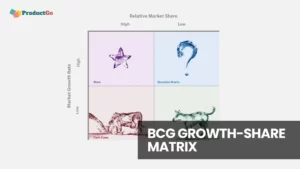In the fast-paced realm of business, a robust product strategy serves as the North Star, guiding a company to success. However, the journey is fraught with common product strategy mistakes that product managers and strategists frequently make. This blog post explores seven of these pitfalls that can lead to costly setbacks and missed opportunities in the world of product management.
Understanding these blunders and their repercussions is vital, as a flawed product strategy can result in products that miss the mark, wasted resources, and lost market share. In today’s dynamic landscape, avoiding these errors is paramount to achieving product strategy success.
What is product strategy?
Product strategy is a high-level plan that outlines how a company’s products or services will achieve its business goals and meet customer needs. It’s like a roadmap for product development and management.

At its core, product strategy involves making important decisions about what products to create or improve, who the target customers are, and how they will stand out in the market. Here are the key elements:
- Vision: A clear vision defines where the product should be in the future.
- Goals: Specific objectives guide the product’s direction and success metrics.
- Market Analysis: Understanding customer needs, competition, and market trends.
- Positioning: Defining how the product differs from competitors.
- Roadmap: A timeline of features and enhancements.
- Resource Allocation: Deciding how to allocate resources like time and money.
- Feedback: Continuously gathering and using customer feedback for improvements.
A strong product strategy aligns everyone in the company toward a common goal, ensuring that the product meets market demands and contributes to the company’s growth.
→ Related content: Product Strategy Framework Elements | Types & Tips with Examples
Mistake 1: Neglecting Market Research
Failing to conduct comprehensive market research is a cardinal sin in product strategy. This mistake can lead to misaligned products, wasted resources, and a competitive disadvantage. Without a deep understanding of customer needs and market trends, product development becomes a shot in the dark.
Avoiding the Mistake
To avoid this blunder, prioritize in-depth research into customer preferences, pain points, and industry trends. Leverage data analytics, customer feedback, and stay updated on market changes.
Market research isn’t a one-time task; it’s an ongoing process that ensures your product strategy remains finely tuned to the evolving landscape, increasing your chances of success.
Mistake 2: Ignoring Customer Feedback
Neglecting customer feedback is akin to steering a ship without looking at the compass. It’s a grave error in product strategy development that can have far-reaching consequences.

Avoiding the Mistake
Effective product strategists understand the invaluable insights that come from their customer base. Here’s how to ensure you’re not making this mistake:
- Actively Listen: Create feedback channels and actively listen to what your customers are saying.
- Feedback Loops: Implement regular feedback loops into your product development process to keep the conversation going.
- User-Centricity: Prioritize customer satisfaction and needs; let these guide your product strategy.
By giving your customers a voice in your product development journey, you not only avoid the mistake of ignoring their feedback but also open the door to innovation and customer satisfaction.
Mistake 3: Underestimating the Competition
Underestimating your competition is a risky move in product strategy. It can leave your product vulnerable to being overshadowed and outperformed in the market. Failing to recognize the strengths and weaknesses of competitors can lead to complacency and missed opportunities for differentiation.
Avoiding the Mistake
To avoid this mistake, delve deep into understanding your competition. Conduct a thorough assessment of your competitors’ products, strategies, and market positioning. Identify their strengths, weaknesses, opportunities, and threats. Keep a watchful eye on competitor movements and adapt your strategy accordingly.
Mistake 4: Lack of Clear Goals and Objectives
One of the most common pitfalls in product strategy is the absence of clear, well-defined goals and objectives. Without a precise roadmap, your team may lack direction, and decision-making can become arbitrary. This mistake can lead to confusion, missed deadlines, and wasted resources. Moreover, it makes it challenging to measure success, as you won’t have specific benchmarks to track progress.

Avoiding the Mistake
To rectify this mistake, establish SMART (Specific, Measurable, Achievable, Relevant, Time-bound) goals:
- Specific: Clearly define what you want to achieve.
- Measurable: Determine how you’ll measure success.
- Achievable: Ensure your goals are realistic and attainable.
- Relevant: Align goals with your overall strategy.
- Time-bound: Set deadlines to create a sense of urgency.
Setting SMART goals provides your product strategy with a clear direction, ensuring everyone knows where you’re headed and how success will be measured.
Mistake 5: Overlooking the Importance of Cross-Functional Collaboration
Neglecting cross-functional collaboration is a significant product strategy mistake. When teams within an organization operate in silos, it can result in disjointed efforts, misalignment of objectives, and inefficient resource allocation. Such isolation can hinder the flow of ideas and inhibit innovation.
Additionally, it often leads to conflicts, misunderstandings, and a lack of shared ownership, which can be detrimental to product development.
Avoiding the Mistake
To rectify this mistake, foster a culture of collaboration across different departments and teams. Encourage clear and open communication, create cross-functional teams that bring together diverse expertise, ensure that teams share common product-related goals and objectives, and schedule regular meetings to facilitate information exchange.
Emphasizing cross-functional collaboration harnesses your organization’s collective intelligence, leading to more innovative and well-rounded product strategies aligned with customer needs and business goals. To improve team collaboration as well as transparency, the user story map is one of the tools you should keep in mind.
Mistake 6: Rigid Adherence to the Plan
Rigidly adhering to a predetermined plan is a common misstep in product strategy. While planning is essential, an unwavering commitment to a fixed strategy can hinder adaptability and responsiveness to changing market dynamics. It can lead to missed opportunities or persisting with strategies that are no longer effective.

In a fast-paced environment, this inflexibility can be detrimental to a product’s competitiveness and long-term success.
Avoiding the Mistake
To overcome this mistake, strike a balance between planning and adaptability. Regularly review your strategy, anticipate potential scenarios with contingency plans, and base changes on data and insights rather than rigidly sticking to the original plan.
Mistake 7: Failure to Measure and Adapt Based on Performance Metrics
Neglecting to measure and adapt based on performance metrics is a critical error in product strategy. Without a clear understanding of how your product is performing, you risk continuing down a path that may not yield the desired results. It can lead to resource waste, missed growth opportunities, and a failure to address issues promptly.
Avoiding the Mistake
To avoid this mistake, prioritize data-driven decision-making:
- Define Key Metrics: Identify key performance indicators (KPIs) that align with your product goals.
- Regular Monitoring: Continuously monitor these metrics to track progress and identify trends.
- Adapt and Optimize: Use insights from the data to adapt your strategy, make informed improvements, and seize growth opportunities.
By integrating data-driven decision-making into your product strategy, you ensure that your approach is dynamic, responsive, and geared towards ongoing optimization and success.
Final Words
Throughout this exploration of seven common product strategy mistakes, we’ve emphasized the importance of research, customer feedback, competition analysis, goal setting, cross-functional collaboration, adaptability, and data-driven decision-making. These are the pillars upon which a robust product strategy is built.
By steering clear of these mistakes and adopting the suggested solutions, you can ensure that your product strategy remains agile, customer-centric, and finely tuned to the dynamic business landscape. Remember, product strategy isn’t a one-time endeavor; it’s a continuous process of improvement and adaptation.
→ Related content: What does a Product Strategist do? Responsibilities & Career Path



